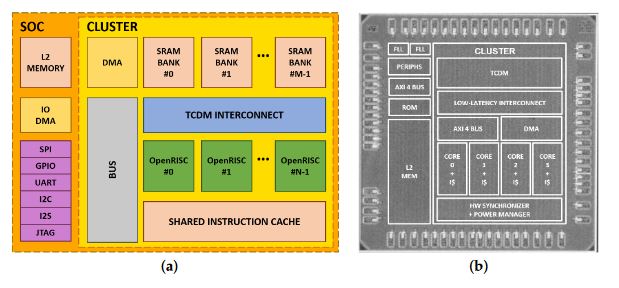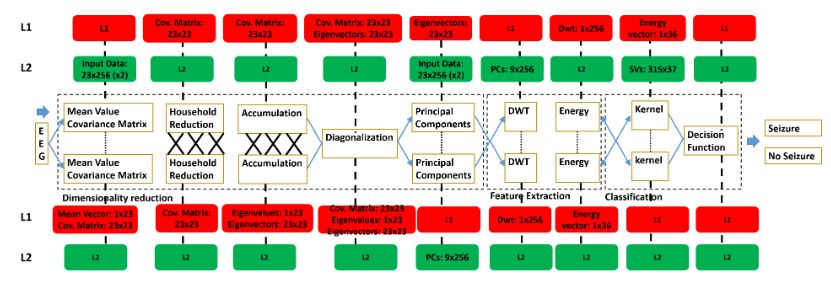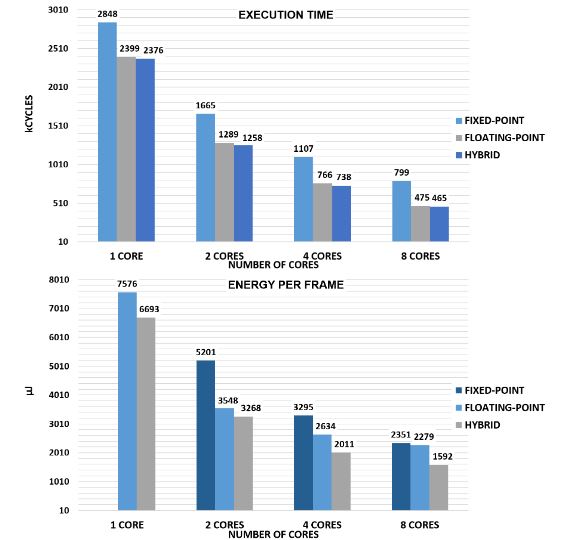ABSTRACT
Ultra-low power operation and extreme energy efficiency are strong requirements for a number of high-growth application areas requiring near-sensor processing, including elaboration of biosignals. Parallel near-threshold computing is emerging as an approach to achieve significant improvements in energy efficiency while overcoming the performance degradation typical of low-voltage operations.
In this paper, we demonstrate the capabilities of the PULP (Parallel Ultra-Low Power) platform on an algorithm for seizure detection, representative of a wide range of EEG signal processing applications. Starting from the 28-nm FD-SOI (Fully Depleted Silicon On Insulator) technology implementation of the third embodiment of the PULP architecture, we analyze the energy-efficient implementation of the seizure detection algorithm on PULP.
The proposed parallel implementation exploits the dynamic voltage and frequency scaling capabilities, as well as the embedded power knobs of the PULP platform, reducing energy consumption for a seizure detection by up to 10 × with respect to a sequential implementation at the nominal supply voltage and by 4.2 × with respect to a sequential implementation with voltage scaling.
Moreover, we analyze the trans-precision optimization of the algorithm on PULP, by means of a hybrid fixed-and floating-point implementation. This approach reduces the energy consumption by up to 43% with respect to the plain fixed-point and floating-point implementations, leveraging the requirements in terms of the precision of the kernels composing the processing chain to improve energy efficiency.
Thanks to the proposed architecture and system-level approach for optimization, we demonstrate that PULP reduces energy consumption by up to 140 × with respect to commercial low-power microcontrollers, being able to satisfy the real-time constraints typical of bio-medical applications, breaking the barrier of microwatts for a 50-ms complete seizure detection and a few milliwatts for a 5-ms detection latency on a fully-programmable architecture.
RELATED WORK
A typical implementation of a BMI includes five main stages: measure of the brain activity, pre-processing, feature extraction, classification and, finally, control stage. The key elements for a seizure detection BMI implementation are the algorithm, which has to be able to detect ongoing seizures with high accuracy and satisfying the real-time constraint, and the architecture, which has to guarantee high computational effort maintaining low energy consumption.
PULP PLATFORM

Figure 1. A general view of the Parallel Ultra-Low Power (PULP) architecture (a) and the layout of the PULPv3 chip used for performance and power characterization
This section describes the PULP platform, focusing on the architecture of its third embodiment fabricated in 28-nm UTBB FD-SOI technology. The computational engine of the SoC is a cluster with a parametric number (2–16) of cores (Figure 1a). The processors are based on power-optimized four-pipeline stage micro-architecture implementing the OpenRISC ISA, featuring full forwarding with single stalls only on load-use and mispredicted branches.
SEIZURE DETECTION ON THE PULP ARCHITECTURE

Figure 2. Seizure detection computational kernels
This section describes the implementation of the seizure detection application on the PULP platform. The application was chosen as a benchmark for PULP as representative for a wide range of bio-processing applications, which consist of the three following steps: dimensionality reduction, feature extraction and classification. A block diagram of the application is shown in Figure 2.
EXPERIMENTAL RESULTS

Figure 4. Comparison between floating-, fixed-point and hybrid execution time and energy per frame
The flexibility of the PULP platform allows one to vary the approach used for execution (to switch from float to fixed and vice versa) on the basis of the kernel and the configuration we are using, to reduce as much as possible the energy consumption. As shown in Figure 4, in this way, even if the execution time of the hybrid approach is nearly similar to that of the floating-point implementation, the energy per frame can be reduced by up to 1.5 × with respect to the fixed-point implementation and 1.4 × with respect to the floating-point implementation for execution on eight cores, significantly improving the energy efficiency of the application.
CONCLUSIONS
This work presented a seizure detection application on a Parallel Ultra-Low-Power (PULP) platform. Starting from the architecture and silicon characterization of the third embodiment of the PULP platform, implemented in 28-nm FD-SOI technology, we analyze the optimized implementation of the seizure detection algorithm, analyzing different solutions, which explore the performance/accuracy trade-off.
The results of our exploration show that PULP platform is an appropriate solution for a biomedical application like seizure detection, and its flexibility and efficient micro-architecture lead to lower execution times and power consumption with respect to other commercial solutions (up to 140 × lower energy). Moreover, the effect of the conversion from floating-to fixed-point format is shown in terms of the precision in the results and accuracy in the classification during a real-time simulation using EEG data acquired from four epileptic subjects.
Furthermore, after an accurate analysis of the performance of each kernel in each configuration (i.e., single or multiple-cores), a hybrid algorithm was implemented combining floating-and fixed-point approaches, obtaining a further energy gain of 39% and 30% with respect to fixed-and floating-point version. In conclusion, it was shown that PULP is able to satisfy the computational requirements of a complex biomedical application for seizure detection without exceeding the power envelope of a few mW, from 13.4 mW with a single core to 3.18 mW with eight cores, imposing a seizure detection latency equal to 5 ms.
Source: University of Bologna
Authors: Fabio Montagna | Simone Benatti | Davide Rossi